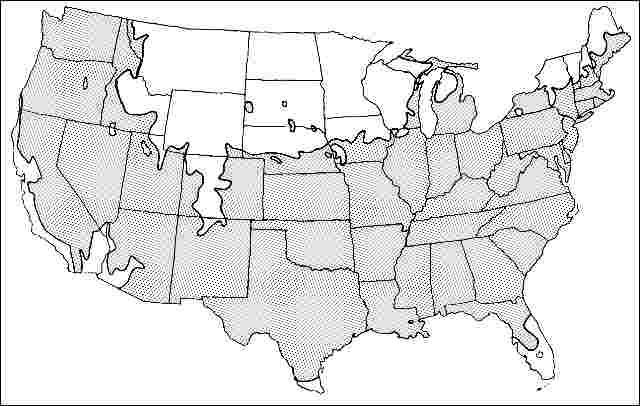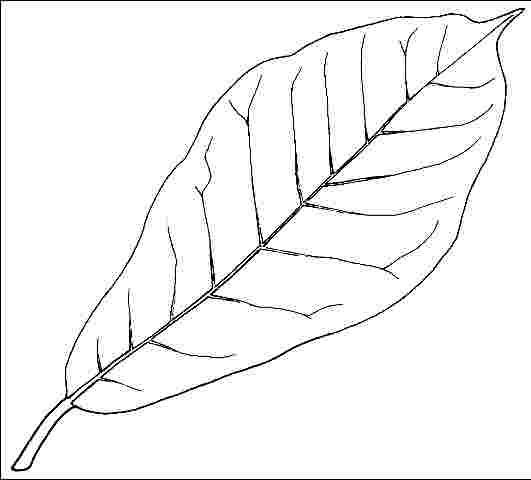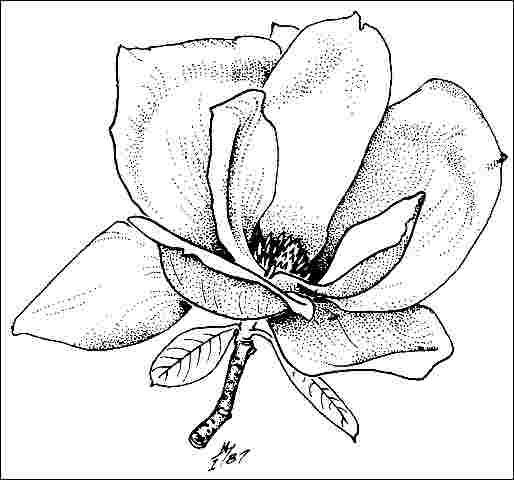Introduction
Saucer magnolia is a multi-stemmed, spreading tree, 25 feet tall with a 20- to 30-foot spread and bright, attractive, gray bark. Growth rate is moderately fast but slows down considerably as the tree reaches about 20-years of age. Young trees are distinctly upright, becoming more oval than round by 10-years-old. Large, fuzzy, green flower buds are carried through the winter at the tips of brittle branches. The blooms open in late winter to early spring before the leaves, producing large, deep-purple flowers, creating a spectacular flower display. This will be a very popular cultivar once the general public finds out about it. However, a late frost can often ruin the flowers in all areas where it is grown. This can be incredibly disappointing since you wait 51 weeks for the flowers to appear. In warmer climates, the late-flowering selections avoid frost damage, but some are less showy than the early-flowered forms which blossom when little else is in flower. ‘Burgundy' is an early flowering selection.

Credit: UF/IFAS
General Information
Scientific name: Magnolia x soulangeana
Pronunciation: mag-NO-lee-uh x soo-lan-jee-AY-nuh
Common name(s): 'Burgundy' saucer magnolia
Family: Magnoliaceae
USDA hardiness zones: 4B through 9A (Figure 2)
Origin: not native to North America
Invasive potential: not assessed/incomplete assessment
Uses: specimen; deck or patio; container or planter; espalier; shade

Credit: UF/IFAS
Description
Height: 20 to 25 feet
Spread: 20 to 30 feet
Crown uniformity: irregular
Crown shape: upright/erect, round
Crown density: open
Growth rate: moderate
Texture: coarse
Foliage
Leaf arrangement: alternate (Figure 3)
Leaf type: simple
Leaf margin: entire
Leaf shape: obovate, oblong
Leaf venation: pinnate, brachidodrome
Leaf type and persistence: deciduous
Leaf blade length: 2 to 4 inches, 4 to 8 inches
Leaf color: green
Fall color: yellow
Fall characteristic: showy

Credit: UF/IFAS
Flower
Flower color: purple
Flower characteristics: very showy

Credit: UF/IFAS
Fruit
Fruit shape: elongated, irregular
Fruit length: 1 to 3 inches
Fruit covering: dry or hard
Fruit color: red
Fruit characteristics: does not attract wildlife; not showy; fruit/leaves not a litter problem
Trunk and Branches
Trunk/bark/branches: branches droop; showy; typically multi-trunked; thorns
Pruning requirement: little required
Breakage: resistant
Current year twig color: brown
Current year twig thickness: medium
Wood specific gravity: unknown
Culture
Light requirement: full sun, partial sun, or partial shade
Soil tolerances: sand; loam; clay; acidic; well-drained
Drought tolerance: moderate
Aerosol salt tolerance: none
Other
Roots: not a problem
Winter interest: yes
Outstanding tree: yes
Ozone sensitivity: unknown
Verticillium wilt susceptibility: susceptible
Pest resistance: resistant to pests/diseases
Use and Management
The tree is best used as a specimen in a sunny spot where it can develop a symmetrical crown. It can be pruned up if planted close to a walk or patio to allow for pedestrian clearance but probably looks its best when branches are left to droop to the ground. The light gray bark shows off nicely, particularly during the winter when the tree is bare.
Saucer magnolia grows best in a sunny location in rich, moist but porous soil. It will tolerate poor drainage for only a short period of time. Growth will be thin and leggy in a shaded spot but acceptable in part shade. Saucer magnolia dislikes dry or alkaline soil but will otherwise grow very well in the city. Transplant in the spring, just before growth begins, and use balled and burlapped or containerized plants. Older plants do not like to be pruned and large wounds may not close well. Train plants early in their life to develop the desired form.
Some saucer magnolia cultivars will be hard to find: ‘Alba'—flowers almost white; ‘Alexandrina'—flowers almost white; ‘Amabalis'—flowers white; ‘Andre LeRoy'—flowers dark pink to purplish outside, cup shaped; ‘Brozzonii'—flowers white shaded with purple; ‘Grace McDade'—flowers white with pink at the petal bases; ‘Lennei'—flowers rosy purple outside, white flushed with purple inside, flowers large, blooms later; ‘Lilliputian'—slow grower to 10 to 15 feet tall; ‘Lombardy Rose'—similar to Lennei except flowers continue to open for several weeks; ‘Niemetzi'—upright growth; ‘Rubra'—(‘Rustica', ‘Rustica Rubra')—similar to ‘Lennei'; ‘San Jose'—large flowers nearly as dark as ‘Lennei'; ‘Speciosa'—similar to ‘Alba' but it is last of the cultivars to bloom, a tall, upright, fast-growing tree; ‘Spectabilis'—flowers almost white; ‘Verbanica'—flowers clear rose pink outside, late blooming, slow-growing to 10 feet tall.
Pests
It is generally pest free. Scales of various types may infest twigs. Magnolia scale is the most common scale and can be one half-inch-across. Overwintering scales are usually controlled with horticultural oil.
Tulip-poplar weevil (sassafras weevil) feeds as a leaf miner when young and chews holes in the leaves as an adult.
Diseases
It is generally disease free. Magnolia may be subject to leaf spots caused by bacteria or a large number of fungi. Leaf spots rarely require chemical controls. Rake up and dispose of infected leaves.
Canker diseases will kill branches. Cankers on branches can be pruned out. Keep trees healthy with regular fertilization and by watering in dry weather.
Verticillium wilt may cause death of a few branches or may kill the tree. Prune out dead branches and fertilize with high nitrogen fertilizer.